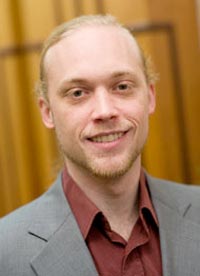This is the latest in a series of profiles of our MIT Energy Fellows—graduate students who are supported by MIT Energy Initiative (MITEI) members to participate in faculty-led research and become part of a long-term community of students and alumni.

As a commodities trader in 2006, Kawika Pierson was struck by how the boom in ethanol demand drove up corn prices, made grain futures skyrocket, spawned new refineries, and led to a spike in supply, which ultimately brought down the price of ethanol.
Pierson, wondering if this kind of cycle might be “a pervasive dynamic throughout the economy,” came to MIT and started exploring energy scenarios in terms of system dynamics. A PhD student in his fourth year at MIT’s Sloan School of Management, Pierson, one of 47 Named Energy Fellows supported by MITEI’s member companies this year, is sponsored by MITEI founding member BP.
System dynamics is an approach to understanding the behavior of complex systems. What separates system dynamics from other types of analysis is its inclusion of internal feedback loops and time delays. These elements, which affect the behavior of an entire system, can make seemingly simple systems bafflingly nonlinear.
One chicken-and-egg problem is how to get hydrogen-fueled cars on the road. Without hydrogen fueling stations, people can’t drive hydrogen-fueled cars; but because there so few hydrogen-fueled cars, hydrogen fueling stations don’t proliferate.
To analyze the behavior of this system over time, Pierson’s advisor, John D. Sterman, the Jay W. Forrester Professor of Management and director of MIT’s System Dynamics Group, developed a model that simulates how markets for alternative fuels vehicles may (or may not) grow.
“When people started to apply system dynamics to business practices, they arrived at some non-intuitive results,” Pierson said. “System dynamics allows you to factor in things like levels of productivity, hiring and firing, and other scenarios you wouldn’t normally be able to experiment with in real life.”
In an ongoing project at MIT, Pierson applied a system dynamics approach to the airline industry’s profit cycles and found that the price of jet fuel may not be the culprit behind the industry’s economic woes.
The airline industry profit cycles looked like this: Each period of five or six good years seemed to be followed by five or six bad years. Airline executives blamed the rise in jet fuel prices for the downturns, but Pierson contends that this displays “a persistent misunderstanding of how the industry really works.”
He learned that when times were good, airlines tended to add more planes to their fleets. Because it takes two years to deliver a plane and orders are hard to cancel once a plane is in production, good times tended to result in airlines buying too many planes. The industry’s high fixed costs—for instance, a plane needs fuel whether carrying one passenger or 100—means that it must lower prices to fill seats in a climate where there’s only so much demand for air travel. Profit margins start to look bleak.
Over time, the capacity of the new planes is filled, prices for seats go back up, and the cycle repeats itself. “If more individual players understand this dynamic, they might be more cautious in ordering new planes,” Pierson said. The same boom-bust cycles, he said, appear to be at play in the petrochemical, insurance, and housing industries.
Looping back
A native of south Florida, Pierson majored in electrical engineering at Northwestern University, where he found “a great professor who really inspired” him and introduced him to systems analysis. Modeling how electrical waves loop through different materials, they designed a cell phone antenna that doesn’t radiate electrical current toward the brain. Unfortunately, Pierson said, their design was not cost-effective enough for manufacturers.
After graduating, Pierson worked as a commodities trader in Kansas City, Beijing, and Los Angeles before enrolling at MIT Sloan. He has served as a teaching assistant for five semesters and was nominated for an Institute-wide teaching medal this year. “I’ve liked teaching my whole life,” he said. “Helping people better understand things is really rewarding. No one feels better about what they do for a living than a teacher, I think.”
He hopes to teach system dynamics, possibly at a small liberal arts university in the mountains, far away, he said, from coastlines potentially endangered by global warming and rising sea levels. Pierson finds Sterman’s projections of global carbon dioxide emissions sobering but, he said, his work and that of the entire MIT Energy Initiative is leading the charge in improving the planet’s long-term outlook.